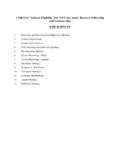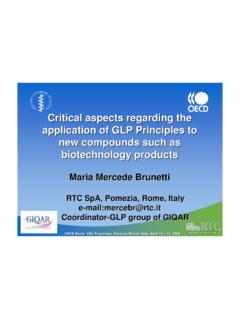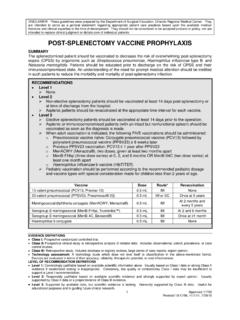Transcription of New Zealand Data Sheet - Medsafe
1 New Zealand Data Sheet 11. PRODUCT NAME LUCENTIS Ranibizumab 10 mg/mL solution for injection 2. QUALITATIVE AND QUANTITATIVE COMPOSITION Active substance One mL contains 10 mg ranibizumab. Vial Each vial contains mg of ranibizumab in mL solution. Pre-filled syringe Each pre-filled syringe contains mg of ranibizumab in mL solution. Ranibizumab is a humanised monoclonal antibody fragment produced in Escherichia coli cells by recombinant DNA technology. Active moiety Ranibizumab. Excipients Alpha,alpha-trehalose dihydrate Histidine hydrochloride, monohydrate Histidine Polysorbate 20 Water for injections.
2 3. PHARMACEUTICAL FORM Solution for injection. Lucentis is supplied in a vial or a pre-filled syringe. Vial Sterile, clear, colourless to pale yellow and preservative-free aqueous solution. Pre-filled syringe New Zealand Data Sheet 2 Sterile, clear, colourless to pale yellow and preservative-free aqueous solution. 4. CLINICAL PARTICULARS therapeutic indications Lucentis is indicated for: the treatment of neovascular (wet) age-related macular degeneration (AMD). the treatment of visual impairment due to choroidal neovascularization, the treatment of visual impairment due to choroidal neovascularisation (CNV) secondary to pathologic myopia (PM) the treatment of visual impairment due to diabetic macular oedema (DME).
3 The treatment of visual impairment due to macular oedema secondary to retinal vein occlusion (branch RVO or central RVO). Dose and method of administration Single-use vial for intravitreal use only. Use of more than one injection from a vial can lead to product contamination and subsequent ocular infection. Lucentis must be administered by a qualified ophthalmologist experienced in intravitreal injections. The recommended dose for Lucentis is mg given as a single intravitreal injection. This corresponds to an injection volume of The interval between two doses injected into the same eye should not be shorter than one month.
4 Treatment of wet AMD, visual impairment due to DME or due to macular edema secondary to RVO, visual impairment due to CNV secondary to PM Treatment is initiated with one injection per month until maximum visual acuity is achieved and/or there are no signs of disease activity no change in visual acuity and in other signs and symptoms of the disease under continued treatment. In patients with wet AMD, DME and RVO, initially, three or more consecutive, monthly injections may be needed. Thereafter, monitoring and treatment intervals should be determined by the physician and should be based on disease activity as assessed by visual acuity and/or anatomic parameters.
5 New Zealand Data Sheet 3If, in the physician s opinion, visual and anatomic parameters indicate that the patient is not benefiting from continued treatment, Lucentis should be discontinued. Monitoring for disease activity may include clinical examination, functional testing or imaging techniques ( optical coherence tomography or fluorescein angiography). If patients are being treated according to a treat-and-extend regimen, once maximum visual acuity is achieved and/or there are no signs of disease activity, the treatment intervals can be extended stepwise until signs of disease activity or visual impairment recur.
6 The treatment interval should be extended by no more than two weeks at a time for wet AMD and may be extended by up to one month at a time for DME. For RVO, treatment intervals may also be gradually extended, however there are insufficient data to conclude on the length of these intervals. If disease activity recurs, the treatment interval should be shortened accordingly. The treatment of visual impairment due to CNV should be determined individually per patient based on disease activity. In the treatment of visual impairment due to CNV secondary to PM, many patients may only need one or two injections during the first year, while some patients may need more frequent treatment (see section , Clinical efficacy and safety).
7 Lucentis and Laser Photocoagulation in DME and branch RVO: Lucentis can be safely administered concomitantly with laser photocoagulation as well as in patients who have received previous laser photocoagulation. When given on the same day, Lucentis should be administered at least 30 minutes after laser photocoagulation. Method of administration As with all medicinal products for parenteral use, Lucentis should be inspected visually for particulate matter and discoloration prior to administration. The injection procedure should be carried out under aseptic conditions, which includes the use of surgical hand disinfection, sterile gloves, a sterile drape and a sterile eyelid speculum (or equivalent).
8 Sterile paracentesis equipment should be available as a precautionary measure. The patient s medical history for hypersensitivity reactions should be carefully evaluated prior to performing the intravitreal procedure (see section ). Adequate anaesthesia and a broad-spectrum topical microbicide to disinfect the periocular skin, eyelid and ocular surface should be administered prior to the injection. For information on preparation of Lucentis, see section The injection needle should be inserted to mm posterior to the limbus into the vitreous cavity, avoiding the horizontal meridian and aiming towards the centre of the New Zealand Data Sheet 4globe.
9 The injection volume of mL is then delivered; the scleral site should be rotated for subsequent injections. Special populations Hepatic impairment Lucentis has not been studied in patients with hepatic impairment. However, as systemic exposure is negligible, no special measures are considered necessary in this population. Renal impairment Dose adjustment is not needed in patients with renal impairment (see section Pharmacokinetic properties). Paediatric patients Lucentis is not recommended for use in children and adolescents due to a lack of data on safety and efficacy in these sub-populations.
10 Limited data on adolescent patients aged 12 to 17 years with visual impairment due to CNV is available (see section , Clinical efficacy and safety, Paediatric patients). Geriatric patients No dose adjustment is required in the elderly. Contraindications Hypersensitivity to the active substance or to any of the excipients. Patients with active or suspected ocular or periocular infections. Patients with active intraocular inflammation. Special warnings and precautions for use Intravitreal injection-related reactions Intravitreous injections, including those with Lucentis, have been associated with endophthalmitis, intraocular inflammation, rhegmatogenous retinal detachment, retinal tear and iatrogenic traumatic cataract (see section Undesirable effects).













